2.7: Autonomous equations
( \newcommand{\kernel}{\mathrm{null}\,}\)
Let us consider general differential equation problems of the form
where the derivative of solutions depends only on
Let us come back to the cooling coffee problem (see Example 1.3.3). Newton’s law of cooling says that
where
Note the solution
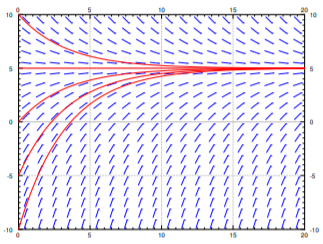
Let us consider the logistic equation
for some positive
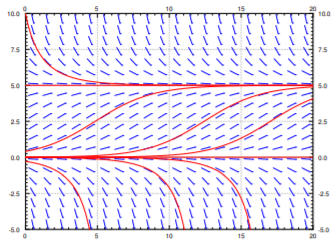
Note two critical points,
It is not really necessary to find the exact solutions to talk about the long term behavior of the solutions. For example, from the above slope field plot, we can easily see that
Where DNE means “does not exist.” From just looking at the slope field we cannot quite decide what happens if
If we are interested only in the long term behavior of the solution, we would be doing unnecessary work if we solved the equation exactly. We could draw the slope field, but it is easier to just look at the or , which is a simple way to visualize the behavior of autonomous equations. In this case there is one dependent variable

Armed with the phase diagram, it is easy to sketch the solutions approximately: As time
Below is a video on solving an autonomous differential equation that describes logistic growth.
Try sketching a few solutions simply from looking at the phase diagram. Check with the preceding graphs if you are getting the type of curves.
Once we draw the phase diagram, we can easily classify critical points as stable or unstable.

Since any mathematical model we cook up will only be an approximation to the real world, unstable points are generally bad news.
Let us think about the logistic equation with harvesting. Suppose an alien race really likes to eat humans. They keep a planet with humans on it and harvest the humans at a rate of
We expand the right hand side and solve for critical points
Solving for the critical points
Below is a video on solving an autonomous initial value problem.
Sketch a phase diagram for different possibilities. Note that these possibilities are
For example, let
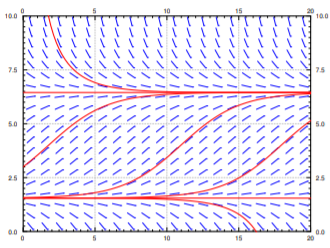
When
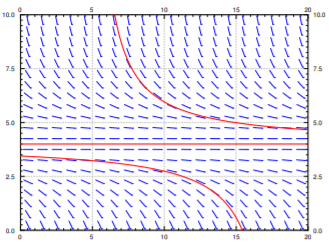
Finally if we are harvesting at 2 million humans per year, there are no critical points. The population will always plummet towards zero, no matter how well stocked the planet starts (see Figure
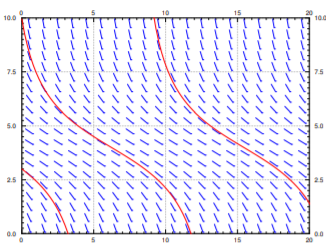
Footnotes
[1] Unstable points with one of the arrows pointing towards the critical point are sometimes called semistable.
References
- Paul W. Berg and James L. McGregor, Elementary Partial Differential Equations, Holden-Day, San Francisco, CA, 1966.
- William E. Boyce, Richard C. DiPrima, Elementary Differential Equations and Boundary Value Problems, 9th edition, John Wiley & Sons Inc., New York, NY, 2008.
- C.H. Edwards and D.E. Penney, Differential Equations and Boundary Value Problems: Computing and Modeling, 4th edition, Prentice Hall, 2008.
- Stanley J. Farlow, An Introduction to Differential Equations and Their Applications, McGraw-Hill, Inc., Princeton, NJ, 1994. (Published also by Dover Publications, 2006.)
- E.L. Ince, Ordinary Differential Equations, Dover Publications, Inc., New York, NY, 1956.




